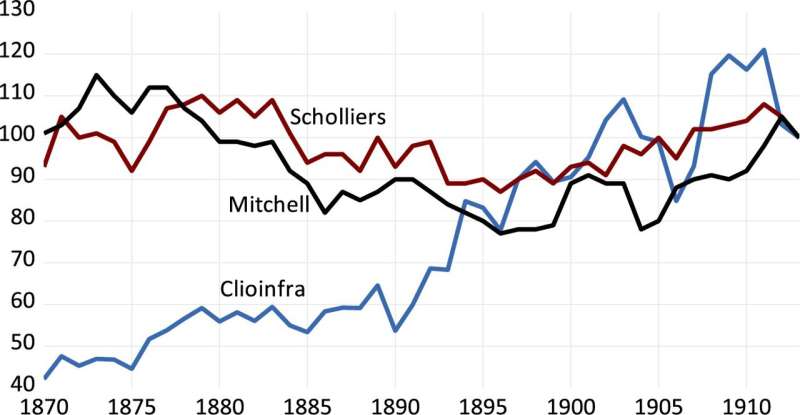This article has been reviewed according to Science X's editorial process and policies. Editors have highlighted the following attributes while ensuring the content's credibility:
fact-checked
trusted source
proofread
Errors detected in several historical consumer price indices

Research from Lund University found several inaccuracies in historical CPIs in popular online databases. The findings, appearing in Cliometrica, can have major consequences for future research. Faults in the data might already have influenced decisions made by politicians regarding economic policy, according to Jonas Ljungberg, Professor emeritus of Economic History.
Jonas Ljungberg needed access to different European countries' consumer price indices (CPIs) for the last 150 years to calculate real exchange rates for a research project. But when he looked at the CPIs listed in popular databases, he found that several of the figures were not reliable.
This discovery led Jonas Ljungberg to launch a new research project in which he went back to the sources and compiled the most credible consumer price indices from 24 European countries between 1870 and 2022.
"I was not overconfident about the accuracy of some of the CPIs from the start, but what I found went beyond my expectations. My research shows that there is a lot of insufficient work behind several of the European consumer price indices that are often used and cited," says Jonas Ljungberg, Professor Emeritus of Economic History at Lund University School of Economics and Management (LUSEM) in Sweden.
'Obvious accounting errors'
Jonas Ljungberg has studied exchange rates, prices and technological change for many years and specializes in measurement problems in economic history. When he went back to the sources that the databases referred to, he found that in the case of Germany, it was a matter of obvious accounting errors.
More specifically, a common source for those who want to find out about historical CPIs is the Clio Infra database, which in turn refers to the compilations of Professor Carmen Reinhart, former chief economist of the World Bank.
"The inflation rate in Germany Reinhart's datasets seems to be twice as high from the 19th century until 1979. This must affect models and series—and in turn analyses and policy decisions," says Jonas Ljungberg.
One possible explanation for the errors, according to Ljungberg, could be that the person who originally handled the data has accidentally duplicated it.
"I did a test and divided Reinhart's figures by two and compared them with the data from her source. It turned out that if you multiply the original source's figures by two, then you got Reinhart's," he says.
Jonas Ljungberg is now calling for further research.
"Inaccurate historical CPIs can have consequences for different decisions and strategies on, for example, inflation control. We cannot afford them to be wrong," he says.
Outdated methods behind French CPI
Other examples of oddities in the statistics do not necessarily have to be accounting errors, but for some countries, a now outdated method was used for the calculation of the CPI. As an example, Jonas Ljungberg mentions the French researcher Jeanne Singer-Kérel who, in her doctoral thesis from 1960, presents two different indices, the "213 articles" and the "214 articles" for the cost of living in France, and it is the latter that has been most widely publicized.
"It may sound as if 214 items are better than 213, but if you look at what is included, you see that the 214th article was "gage" or wages of servants and this index was intended to measure the cost of living for a well-off family," says Jonas Ljungberg.
However, he points out that even the 213 index (which focuses more on a working-class family) has some shortcomings, not least because it uses a fixed weighting for over a century.
"What is remarkable in the case of Singer-Kérel's indices, however, is that in the same thesis, there is a modern index, where the weights change over different historical periods. I recommend that this is the index that should be used," says Jonas Ljungberg.
Before the final publication of the article, Jonas Ljungberg made a working paper available for other researchers to review and provide feedback. This allowed him to follow up on several interesting leads, for example on consumer price indices for Serbia and Germany.
Jonas Ljungberg Q&A about the historical CPI research
How serious a problem is it when historical consumer price indices turn out to be partly wrong?
The analyses by Carmen Reinhart and Kenneth Rogoff have had a huge impact. They were used to justify a shift in economic policy in the years following the 2008 financial crisis—from stimulus to austerity. Many researchers also use the data in their scientific papers.
What can CPIs be used for?
They can be used, for example, to analyze inequality, income inequality and real wage growth. It is central to economic statistics. Inflation targeting is not so dependent on historical data, but it is important in economic modeling that then guides economic policy.
You have created a database that can be downloaded from the Economic History Department website (an Excel sheet with all the CPIs and the countries you have analyzed). Are these CPIs that you have adjusted?
These are the consumer price indices that I recommend. They are probably the best figures you can find at the moment. For some countries, there is quite a lot of uncertainty, but by comparing different countries you can see where more research is needed to get better historical CPIs.
More information: Jonas Ljungberg, European consumer price indices since 1870, Cliometrica (2024). DOI: 10.1007/s11698-024-00283-6
Provided by Lund University




















